- TOP
- Zairyo-to-Kankyo
- Vol. 64 (2015), No. 1
Zairyo-to-Kankyo Vol. 64 (2015), No. 1
Backnumber
-
Vol. 74 (2025)
-
Vol. 73 (2024)
-
Vol. 72 (2023)
-
Vol. 71 (2022)
-
Vol. 70 (2021)
-
Vol. 69 (2020)
-
Vol. 68 (2019)
-
Vol. 67 (2018)
-
Vol. 66 (2017)
-
Vol. 65 (2016)
-
Vol. 64 (2015)
-
Vol. 63 (2014)
-
Vol. 62 (2013)
-
Vol. 61 (2012)
-
Vol. 60 (2011)
-
Vol. 59 (2010)
-
Vol. 58 (2009)
-
Vol. 57 (2008)
-
Vol. 56 (2007)
-
Vol. 55 (2006)
-
Vol. 54 (2005)
-
Vol. 53 (2004)
-
Vol. 52 (2003)
-
Vol. 51 (2002)
-
Vol. 50 (2001)
-
Vol. 49 (2000)
-
Vol. 48 (1999)
-
Vol. 47 (1998)
-
Vol. 46 (1997)
-
Vol. 45 (1996)
-
Vol. 44 (1995)
-
Vol. 43 (1994)
-
Vol. 42 (1993)
-
Vol. 41 (1992)
-
Vol. 40 (1991)
Keyword Ranking
13 Dec. (Last 30 Days)
Zairyo-to-Kankyo Vol. 64 (2015), No. 1
Effect of Cr and Ni on SCC Susceptibility in Non-sensitized Materials under Simulated BWR Condition
Manabu Kanzaki, Kiyoko Takeda, Yasuhiro Masaki, Takeo Kudo
pp. 8-13
DOI:
10.3323/jcorr.64.8Abstract
The effect of Cr and Ni on Stress Corrosion Cracking (SCC) susceptibility was studied in non-sensitized materials under simulated BWR condition. SCC tests were conducted by creviced 4 bent beam test as static strain method, and Slow Strain Rate Test (SSRT) as dynamic strain method. Cr affected markedly to prevent SCC in both SCC tests. Ni was effective to reduce SCC susceptibility under the dynamic strain test, however, not clear to affect SCC susceptibility under the static strain test. The effect of Cr was discussed for corrosion resistant film by examining strain electrode behavior and corrosion products. With increasing the Cr content in material, the repassivation behavior was improved and Cr concentration in inner side of corrosion product increased. These results suggest that Cr affects to suppress SCC due to improve corrosion resistance by Cr concentrated corrosion film.
Corrosion Rate for Silver Exposed to Indoor Atmosphere
Rintaro Minamitani
pp. 14-19
DOI:
10.3323/jcorr.64.14Abstract
A new mechanism of atmospheric corrosion was proposed for silver in H2S-NO2-SO2-Cl2 environments. Hydrogen sulfide is oxidized by nitrogen dioxide to form reduced sulfur. The chemical reaction for silver was worked out by using the generated reduced sulfur. After the generation reaction of reduced sulfur, the electrochemical reaction was worked out by using the surplus hydrogen sulfide or the nitrogen sulfide. A novel estimation equation of the corrosion rate for silver was proposed as a function of both pollutant concentration and temperature-humidity. By using the equation, the experimental data in published papers was able to be estimated by a factor of two.
Readers Who Read This Article Also Read
Zairyo-to-Kankyo Vol.64(2015), No.5
Zairyo-to-Kankyo Vol.64(2015), No.8
Article Access Ranking
13 Dec. (Last 30 Days)
-
Delayed Fracture Mechanism of 1700 MPa-Class Quenched and Tempered Bolt under Atmospheric Corrosion Environment
Tetsu-to-Hagané Advance Publication
-
Perspectives on the Promising Pathways to Zero Carbon Emissions in the Steel Industry toward 2050
ISIJ International Vol.65(2025), No.2
-
Effect of B on Surface Oxidation Behavior and Phosphatability of Si-Mn-added Cold-Rolled Steel Sheets
ISIJ International Advance Publication
-
Factors Influencing the Bonding Phase Structure of Iron Ore Sinters
ISIJ International Vol.43(2003), No.9
-
Effect of microstructural heterogeneity on fatigue limit of as-quenched low-carbon low-alloy martensitic steel
ISIJ International Advance Publication
-
Prussian blue as a fully reversible hydrogenochromic material for visualizing hydrogen distribution in Fe sheet
ISIJ International Advance Publication
-
Progress of Strip Casting Technology for Steel; Historical Developments
ISIJ International Vol.52(2012), No.12
-
Research Progress on Optimal Blending of Iron Ore Powders for Sintering
ISIJ International Vol.65(2025), No.12
-
-
Microstructures and Reduction Properties of High CaO Concentration Sintered Ore
ISIJ International Advance Publication
You can use this feature after you logged into the site.
Please click the button below.










